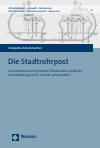Die Stadtrohrpost
Geschichte einer kritischen Infrastruktur in Berlin und Hamburg im 19. und 20. Jahrhundert
Zusammenfassung
Mit dem Bau von Infrastruktursystemen geht die Erwartung einher, dass diese eine lange Zeit überdauern und in ihrer Form stabil bleiben. Stadtrohrpostsysteme, wie man sie aus dem 19. und 20. Jahrhundert kennt, werden heute nicht mehr betrieben. Daher untersucht diese Studie, anhand einer Analyse der Rohrpostnetze Berlins und Hamburgs, die Funktion sowie die Kritikalität von Stadtrohrpostsystemen. Interdisziplinäre Ansätze aus der Infrastruktur- und der KRITIS Forschung werden genutzt, um die Netzstrukturen und Zirkulationsweisen der Stadtrohrpost im Stadtraum herauszuarbeiten. Dabei wird der Blick auf Wandlungsprozesse, Nutzergruppen, Zeitlichkeit und den fortschreitenden Relevanzverlust der Technik gelenkt.
Abstract
The construction of infrastructure systems implies the expectation that the systems will last a long time and remain stable. Urban pneumatic tube systems, as they are known from the 19th and 20th century, do not exist anymore. Therefore, this study, based on an analysis of the pneumatic tube networks of Berlin and Hamburg, examines the function as well as the criticality of city pneumatic tube systems. Interdisciplinary approaches from infrastructure and CRITIS research are used to elaborate the network structures and modes of circulation of urban pneumatic tube mail in urban space. The focus is on processes of change, user groups, temporality and the progressive loss of relevance of the technology.
Schlagworte
19. Jahrhundert 19th century 20. Jahrhundert 20th century Berlin communication critical infrastructure Deutschland Geschichte Germany history Hamburg Infrastrukturforschung infrastructure research Kommunikation loss of relev Kritikalität pneumatic tube network processes of change KRITIS Forschung kritische Infrastruktur temporality urban pneumatic tube systems Nutzergruppen Relevanzverlust urban space Rohrpostnetz user groups Stadtraum Stadtrohrpostsysteme Technik Wandlungsprozesse Zeitlichkeit Zirkulation- 21–42 1 Einleitung 21–42
- 257–266 4. Fazit 257–266
- 267–268 Gedruckte Quellen 267–268
- 269–270 Literatur 269–270
- 271–272 Broschüren 271–272
- 273–278 Literatur 273–278
- 279–280 Archivalien 279–280

